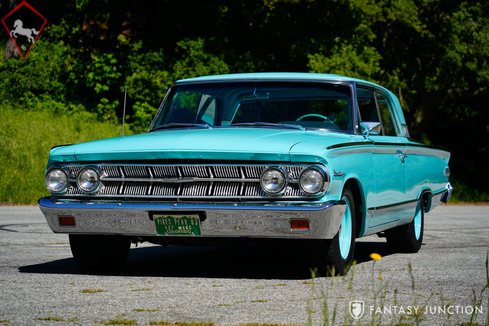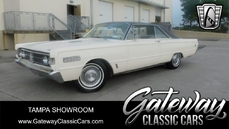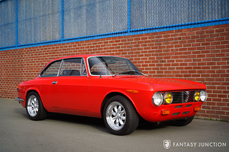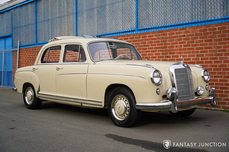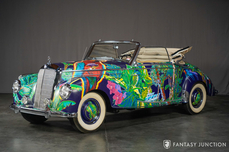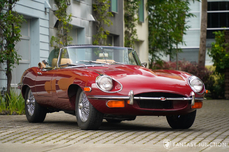Mercury Monterey 427ci V8 1963
Allgemeine Beschreibung :
1963 Mercury Monterey S-55 427 (auction ends June 26th 2022)
Chassis Number – 3267Z500398
Engine Number – F6I9FC
Exterior Color – Peacock Turquoise
Interior Color – Turquoise Vinyl
Engine Type – 427 cu. in. 4-barrel V8
Transmission – 4-Speed Manual
Current Miles –14,000 (TMU)
General History
Developed as part of the full-sized lineup of Ford products, the Mercury S-55 was designated as the performance variant uniquely for the popular Monterey line. The S (Special) served as the companion moniker to the Galaxie 500 XL, which was already making headway in the budding muscle car market. Offered in 1962 and 1963 as first-generation models, the top-of-the-line engine option was the potent 427 (offered only in 1963) with the S-55 package. The S-55 saw few orders for the 427, most of which wound up as stripped down drag cars. By 1964 the S-55 was falling out of favor and eventually ended in 1967 as mid-sized performance cars became more popular.
History of this Mercury S-55
This car bears the following numbers on the data plate affixed to the door.
Body 65C – Two door “S-55” Hardtop
Color B – Peacock Turquoise
Trim 57 – Light Turquoise
Date 11J – September 11
Axle 1 – 3.00:1
Trans 4 – Automatic
Engine Z – 390 Four-Barrel
Vehicle Warranty Number – 327Z500398
One of 3,865 built with the innovative “breezeway design” roof and retractable rear window, this is an early production car originally delivered with a 390 engine and automatic transmission. Shortly after delivery, this car was reportedly prepared with a 427 engine and 4-speed transmission, reflective of the top-level engine package offered in these cars when new. As part of the history of this car, racing legend Parnelli Jones worked closely with Bill Stroppe early in his career on a specially prepared Mercury Marauder to race in the 1963 Pikes Peak International Hill Climb. To meet that challenge, Stroppe built a series of cars for Parnelli to practice his run up Pikes Peak. This car is reportedly one of those vehicles, as detailed in the 1963 Motor Trend magazine and documented in the framed presentation panel accompanying this car. This and other practice race cars were constructed with 427 engines, T-10 transmissions, coil-over shock absorbers, and heavy-duty traction bars.
During Parnelli’s practice sessions, with Parnelli at the wheel, this car is said to have been involved in a return run down the hill, making contact with another car on the uphill side. Though damage was not severe and confined to the left front side of the car, Parnelli was ticketed and fined. Three days later he would go on to win the 1963 race and set a stock car record speed for the course. After the damage was professionally repaired, the car was sold on February 4, 1964, by Bob Foss Motors, Colorado Springs, CO (invoice of purchase included with the car). In 1999 when Parnelli Jones returned to Pikes Peak he personally signed the center console lid of this car. His signature remains on the car today.
Under prior ownership, this car has been comprehensively refurbished. The engine was reportedly rebuilt to match the specifications when built by Stroppe for Parnelli Jones. The engine build was performed by Ricky Freeman of RF Racing including .030” oversize pistons, honed cylinders, new rings, re-sized rods with new Clevite bearings, reground crankshaft, new Comp Cams camshaft and solid lifters, new timing chain and gears, new Melling high pressure oil pump, rebuilt heads with stainless steel valves, rebuilt Holley carburetor (correct for 427), and fresh high temperature valve cover and oil pan gaskets.
The current and consigning owner, a vintage car collector, purchased this car in 2015 and has performed regular fluid services and general maintenance as needed with his internal shop staff. Items more recently purchased for the car include new carpet for the lower door panels, a new tinted windshield, a passenger side turquoise arm rest (original included with spares), an 8-ball shift knob and matching door lock buttons, a power seat switch, and other minor trim pieces for the interior.
General Overview
Finished in the original and very striking Peacock Turquoise with matching turquoise blue interior, the car presents as a handsome example of restoration and original features. The paint is smooth and glossy, showing virtually no signs of age or significant paint blemishes to the high-quality finish. The exterior chrome and trim are excellent throughout. The stainless and aluminum trim are properly polished, and the rare features unique to this S-55 series are in excellent condition including the unique “Breezeway” roll down rear window. The car sits on modern radial tires with matching turquoise steel rims finished with polished Mercury “dog-dish” hubcaps. Exceptionally rare trim, trunk panel garnish molding, and C-post features are very hard to find in such excellent condition.
The interior appears to be largely original and very well preserved. The material textures, color breaks, and seat patterns delight the eye at every corner. The padded dash and colorful instrument cluster are enhanced by chrome features worthy of a concept car from the 1960s. The interior condition is very rewarding with original front and rear seats, Minor wear can be seen on the driver’s side seat bolster and piping. Carpeting appears to have been replaced as has the lower door carpet, however door panels, rear seat and side panels and other features appear to be original to the car. A set of matching blue seat belts are installed in the front seats. The full-sized steering wheel with safety-recessed center hub is adorned with chrome much like the dash and door panels, glinting with elements of high-end quality and appeal, befitting the top-of-the-line full-sized Mercury of the day. A factory AM radio is in place and a VDO tachometer is installed on the fluted center console in front of the 8-Ball topped 4-speed manual shifter.
Under the hood, the four-barrel 427 cu. in. V8 engine is topped with a modern stamped metal air cleaner, feeding the 4 bbl Holley carburetor. The engine compartment finishes appear to have been restored likely when the engine was removed for rebuild. Attention to detail is quite nice capturing correct factory finishes and generally correct details with some allowances for the performance updates. Correct type cast iron exhaust manifolds, chrome plated valve covers, and an unfinished satin brass surge tank are just a few of the features under the hood. Power disc brakes and power steering are installed and a large diameter hole at the base of the cowl indicates the history of possible rudimentary cowl induction experimentation from the original build. The trunk is properly lined with a correct pattern mat, body color finishes, and full-sized spare tire as well as factory jack and platform stand. Finishes in the trunk appear original to the car including the underside of the trunk lid, still retaining the original jacking instruction sticker. Underneath the car, the chassis appears largely original with evidence of use but still presenting dry, clean components and a sturdy frame. Heavy duty traction bars, 9” rear end, modern KYB rear shocks with air suspension, and dual exhaust contribute to the performance history of this S-55 Mercury.
The car starts easily and reliably with a deep dual exhaust rumble from the potent V8 engine. The shifter engages easily for smooth starts and, once underway, the performance comes on strong with stump-pulling torque and progressive acceleration, especially in higher revs. Highway driving is smooth and less lofty than one might expect for this era, consistent with the suspension modifications. Even with original four-wheel drum brakes this car benefits from power assist and 4-speed manual transmission to deliver braking just a bit better than what might be expected from cars of this era.
Included with this car
The car is accompanied by a set of full wheel covers, a set of rubber floor mats, an original set of rear arm rests, the original passenger’s side armrest, a tire iron, 1963 Ford paint color chart, a 1963 Mercury owner’s manual, and a framed storyboard presentation panel presenting Parnelli Jones’s involvement.
https://fantasyjunction.com/inventory/1963-mercury-monterey-s-55-hardtop/overview
1963 Mercury Monterey 427ci V8 is listed verkauft on ClassicDigest in Emeryville by Fantasy Junction for Preis nicht verfügbar.
Fakten der Auto
Karosserietyp : Auto Marke : Mercury Modell : Monterey Ausführung : 427ci V8 Hubraum : 0.0 Modelljahr : 1963 Lage : Emeryville Fahrzeug Anmeldung : Normal
Verkauft
Angaben Zum Verkäufer
Verkauft
People who viewed this Mercury Monterey also viewed similar Mercury listed at ClassicDigest
Other cars listed for sale by this dealer
über Mercury
Mercury, die Automarke, hat eine reiche Geschichte, die über ihre Rolle in der Anpassungs- und Hot-Rodding-Szene hinausgeht, insbesondere mit dem ikonischen Mercury Eight. Hier sind einige wichtige Punkte über Mercury:Gründung und Frühe Jahre:
Mercury wurde 1938 von der Ford Motor Company als Mittelklassemarke eingeführt und positionierte sich zwischen den erschwinglichen Ford-Modellen und der Luxus-Lincoln-Reihe. Die Marke sollte die Lücke zwischen diesen beiden Segmenten füllen.
Mercury Eight:
Der Mercury Eight, eingeführt im Jahr 1939, ist vielleicht das bekannteste Modell in der Geschichte der Marke. Er zeichnete sich durch ein elegantes Design und einen leistungsstarken V8-Motor aus. Dieses Modell wurde für die Anpassung und das Hot-Rodding populär und hat einen bedeutenden Platz in der amerikanischen Automobilkultur eingenommen.
Kultur der Anpassung:
Der Mercury Eight mit seinem unverwechselbaren Design und einem relativ erschwinglichen Preis wurde zu einem Favoriten unter den Bauherren von maßgeschneiderten Autos. Er spielte eine entscheidende Rolle in der Entwicklung der Kultur der maßgeschneiderten Autos und Hot Rods, insbesondere in der Nachkriegszeit.
Lead Sleds und Anpassung:
Der Begriff "Lead Sled" wird oft mit stark angepassten Autos aus den 1940er und 1950er Jahren in Verbindung gebracht. Diese Autos, einschließlich des Mercury Eight, wurden oft mit tiefergelegten Aufhängungen, gekürzten Dächern und anderen stilistischen Veränderungen modifiziert. Lead Sleds waren ein herausragender Bestandteil der Kultur der maßgeschneiderten Autos, und der Mercury Eight war eine beliebte Wahl für solche Modifikationen.
Wohlstand der Nachkriegszeit:
In der Nachkriegszeit erlebte Mercury, wie viele andere amerikanische Automobilhersteller, einen Aufschwung der Popularität, als die Wirtschaft florierte. Die Marke trug zur Faszination für stilvolle und leistungsstarke Autos dieser Ära bei.
Entwicklung von Modellen:
Im Laufe der Jahre produzierte Mercury verschiedene Modelle und trug so zum Angebot von Ford bei. Einige bemerkenswerte Modelle sind der Mercury Monterey, der Mercury Comet und der Mercury Cougar.
Niedergang und Einstellung:
Trotz Phasen des Erfolgs hatte Mercury Schwierigkeiten, eine eindeutige Identität neben Ford zu etablieren. Mit dem Wandel der Verbraucherpräferenzen kämpfte die Marke, und Ford kündigte schließlich 2010 die Einstellung von Mercury an.
Erbe in der Populärkultur:
Mercury, insbesondere Modelle wie der Mercury Eight, nimmt einen bedeutenden Platz in der amerikanischen Populärkultur ein. Die Verbindung zur Szene der Anpassung und des Hot-Rodding sowie das unverwechselbare Design haben einen nachhaltigen Einfluss hinterlassen.
Zusammenfassend lässt sich sagen, dass der Mercury Eight für seine Rolle in der Kultur der Anpassung und des Hot-Rodding gefeiert wird, während Mercury als Marke eine breitere Rolle in der Automobilgeschichte spielte, indem sie zum mittelpreisigen Segment beitrug und die Automobil-Trends ihrer Zeit widerspiegelte.
